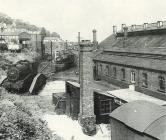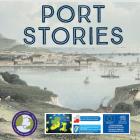Content can be downloaded for non-commercial purposes, such as for personal use or in educational resources.
For commercial purposes please contact the copyright holder directly.
Read more about the The Creative Archive Licence.
Description
Lede
Virginia Woolf is best known as a pioneering novelist and key member of the Bloomsbury group, but her diaries and letters show that she was also an experienced traveller, and travel writer. She visited Ireland only once, but her conflicted responses to the people and places she encountered there cast some light on metropolitan British attitudes towards Ireland in the 1930s.
Story
Virginia Woolf travelled widely in Britain and Europe throughout her life, but visited Ireland only once. On 27 April 1934, she sailed out from Fishguard to Cork for a motoring tour with her husband Leonard, visiting the novelist Elizabeth Bowen at Bowen’s Court, Kildorrery, before heading up the west coast to Galway and the Aran Islands. After a short stay in Dublin, she returned to London via Holyhead after some two weeks away.
The spring weather on the outbound journey was typically changeable. ‘We’ve driven all across Wales today in storms and sudden blasts of sunlight when all the sheep and gorse blazed white and yellow’, Woolf wrote to Ethel Smyth, as she waited at the Fishguard Bay Hotel for the overnight ferry (Letters, 296). Writing to her nephew Quentin Bell, she also rehearsed familiar anxieties about sea travel: ‘all points to death by drowning in the Irish channel. It is pouring and howling. I can see the boat rocking even in the harbour … how I envy you sleeping on dry land’ (Letters, 297).
Woolf’s next letters and diary entries, written from County Cork, record her initial impressions of Ireland. She was struck by its beauty and ‘melancholy’ (a repeated word for Ireland in her diary and letters), and by ‘a sense that life is receding’ (Diary, 209). For Woolf, the emptiness of the landscape – ‘great stretches of virgin sea shore’ (Diary, 209) – reflects the condition of Ireland’s society. Ireland appears, she thinks, like Italy, Greece or Cornwall, only ‘wilder’, and frequently deserted – ‘everybody lamenting, because nobody comes any more, and the gentry have all fled’, she noted to her sister, Vanessa Bell (Letters, 299).
Woolf’s Irish tour made a lasting impact on her. The journey back to London, recorded in snippets of observation in her diary, suggests that she spent some time weighing up what she had seen. Nostalgia, and anxiety for changing times, characterise these reflections, which she voiced via characters encountered on the tour – a verger, a shopkeeper – who ‘would gladly have done with the President of the Free State’ (Diary, 218). ‘“We dont [sic] want this hate – it does nobody any good” as the porter at Holyhead said to me this morning when he remarked how few cattle now came over’ (Diary, 218).
Factoid
Virginia Woolf made use of her trip to Ireland for her 1937 novel, The Years.





Do you have information to add to this item? Please leave a comment
Comments (0)
You must be logged in to leave a comment